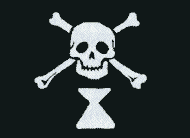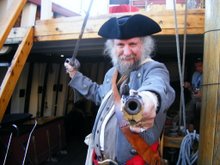I've been doing presentations on navigation for twenty years but I seldom have enough time to get into the details. It has been a while since I have posted more here than just even write-ups so I am overdue for something with some meat on it.
Navigation breaks down into three parts - figuring where you are going, recording where you have gone, and computing where you are. All of this applies to open water navigation. Simply following the coast does not require any special skills or knowledge.
The first part of navigation is known as "loxodromic navigation". This consists of figuring the proper heading to get from one point to another. To sail from New York to London you sail at 73 degrees. Since period compasses had 32 points instead of 360 degrees, this meant sailing East-northeast.
Loxodromes are also known as rhumb lines.
Because maps are a flat projection of a round surface, getting the rhumb line correct can be difficult. Also, maps of the period were not particularly accurate so you might sail to the proper place on the map and discover that you are still in the wrong place. My navigation display includes a map of the Atlantic in which Florida is too small and at the wrong angle. Anyone sailing for Florida using this map would hit land far east of where it shows.
In general, large scale maps were worse than small scale ones.
In addition to these problems, the wind seldom cooperates. Chances are that you will not be able to sail a direct course to your destination. That means that you have to keep track of where you have gone in order to figure where you are. This is known as "dead reckoning".
There are special tools used for dead reckoning navigation. The first is the sand glass. This is a half-hour glass. Every half hour it is turned and the current speed and heading are marked. A board called a "traverse board" was used for this. It had a face that looked like a compass with eight concentric circles of 32 holes (256 holes total). The first time the glass is turned a pin will be placed in the innermost hole corresponding to the current heading. The second ring of holes is used for the next reading and so on for eight turnings of the glass.
At the same time the ship's speed would be measured by throwing the end of a knotted line overboard and timing it with a small sand glass. When the glass ran out you would count the knots that had unspooled. Nautical speed is still called "knots" because for centuries it was measured by knots in a string. There was a scale for recording this at the bottom of the traverse board (to save space it was usually two scales of four hours each). At the end of a four hour shift the board would have eight measurements. These would be recorded for the navigator. He would then plot out the position on a chart.
The navigator would also have to estimate drift. This was done by dropping a weighted line in clear water and seeing how much it bowed away from straight. There were no tools to help with this. It had to be done by eye and experience.
All of this gave crude approximations and in heavy storm sailors often stopped measuring speed or direction. A navigator could check his calculations using the sun and the stars. There were several tools that could be used for this including the quadrant, the astrolabe, the cross staff, and the backstaff (which was only suitable for measuring the sun). None of these could give longitude (east and west), only latitude (north and south).
Sighting the North Star was the easiest. Whatever angle it is at is your latitude. But it is a star and harder to see in clouds or a haze. Also, as Columbus noted, the North Star moves slightly during the night.
Finding the latitude with the sun requires several sightings taken around noon. The highest one is local noon. This angle is subtracted from 90 (because it is relative to the equator instead of the north pole). The high point of the sun moves from one day to the next as the Earth tilts on its axis. Twice a year on the equinox the sun is directly above the equator and no other measurements need to be taken. The rest of the year the navigator needs an almanack. This gives the correction for the date but it requires the navigator to know the approximate latitude. After this correction has been applied then the navigator has his latitude.
It was notoriously difficult to get a good reading on the sun or the north star while on a moving ship. Because of the crudity of the instruments, latitude figured on dry land could be off as much as 80 miles. On a ship that could be 300 miles.
There were other ways of checking your location. Islands often have clouds hanging over them that can be seen even when the island itself is below the horizon.
The sea bottom can be a source of information if it is shallow enough to measure. Depth was measured with a sounding lead. This was a long piece of lead attached to a long rope. The rope was marked at six foot intervals with standard markings. The first fathom was normally a leather strip with two ends. The second one had a leather strip with three ends. The third one had a white rag. The fourth had a red rag. Etc.
The bottom of the sounding lead had a hollow spot that was filled with brown tallow (meat fat). Just before the lead was dropped a fresh coat of white tallow would be applied. This is soft and sticky enough to bring up the soil from the bottom.
A detailed chart would indicate what sort of bottom was in different areas and indicate the depth.
Even if you were out of sight of land you might discover some useful information. Rivers will deposit silt miles from land so they can be detected while in open ocean.
Even with all of these tools, navigation was a hit-and-miss art. Some navigators would play it safe by going to the correct latitude first then sailing east or west to their destination. This was an opportunity for pirates. They could increase their chances of finding prey by cruising back on forth along well-traveled latitudes.
Subscribe to:
Post Comments (Atom)


No comments:
Post a Comment